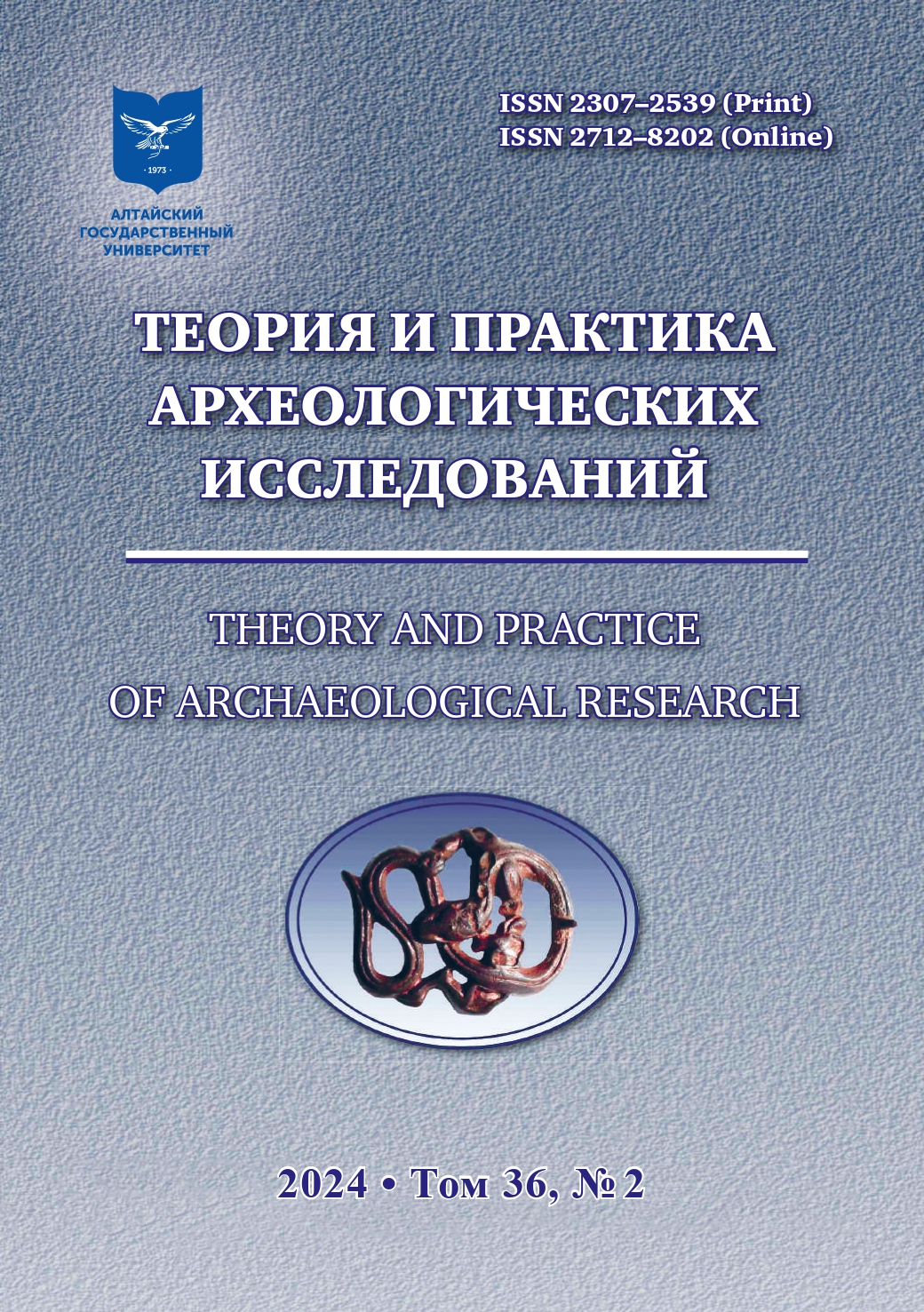THE RESULTS OF THE MICROMORPHOLOGICAL STUDY OF CERAMICS OF THE DON SETTLEMENTS OF THE GORODETS CULTURE
Abstract
The article presents the results of petrographic analysis of 80 samples of ceramics of five settlement sites of the 5th–3rd centuries BC, located in the forest-steppe part of the Don basin. Data on the mineral and chemical composition of the clay, the formulation of molding masses and the modes of vessel firing are given, most of which had a “matting” surface. For the discharge of dishes, mainly lean clay were used, related in composition to 13 varieties. They were accompanied with sand, gruss (crushed magmatic breeds) and chamotte (crushed ceramics, as a rule, differing in composition from the sample). The most popular were mixtures such as sand + gruss and sand + gruss + chamotte. They are detected in almost 70% of samples. The bulk of the vessels (64%) was fired in the oxidative environment. The temperature regime of firing, as a rule, was 600–800 °C. A distinctive feature of Gorodets dishes of Don region is an admixture of gruss. According to the recipe for molding masses, ceramics are similar to the products of the potters of Scythoid culture, whose settlements were also common in the region.Downloads
Metrics
References
Bobrinsky A.A. The Pottery-Making of Eastern Europe: Sources and methods of study. Moscow : Nauka, 1978. 272 p. (In Russ.).
Bobrinsky A.A. Pothair Technology as an Object of Historical and Cultural Study. In: Actual Problems of Studying Ancient Pottery. Samara : Izd-vo SamGPU, 1999. Pp. 5–109 (In Russ.).
Vasilieva I.N. On the Allocation of the Types of Initial Plastic Raw Materials of the Oldest Ceramics and Their Areas in the Neolithic Era (according to the materials of the Volga basin). In: Modern Approaches to the Study of Ancient Ceramics in Archaeology. Moscow : Institut arheologii RAN, 2015. Pp. 16–23 (In Russ.).
Volkova E.V., Denisov A.V., Kuznetsov P.F., Mochalov O.D., Salugina N.P. A Collection of Finds of the Early Iron Age from the Settlement near the Village of Krasnosamarskoye. Arheologiya evrazijskih stepej = Archaeology of the Eurasian Steppes. 2022;2:406–417. (In Russ.). DOI: 10.24852/2587-6112.2022.2.406.417
Glushkov I.G. Ceramics as a Historical Source. Novosibirsk : Izd-vo In-ta arheologii i etnografii SO RAN, 1996. 328 p. (In Russ.).
Kulkova M.A. Petrographic Analysis in the Assessment of Molding Masses when Studying Ancient Clay Dishes. Samarskiyj nauchnyj vestnik = Samara Scientific Bulletin. 2015;3:100–107 (In Russ.).
Levenok V.P., Mironov V.G. To the Question of the New Area of the Gorodets Culture on the Don. Sovetskaya arheologiya = Soviet Archaeology. 1976;2 15–32. (In Russ.).
Medvedev A.P. Early Iron Age of Forest-Steppe Don. Archaeology and Ethnocultural History of the 1st Millennium BC. Moscow : Nauka, 1999. 160 p. (In Russ.).
Merkulov A.N., Razuvaev Yu.D., Kulkova M.A. To the Study of the Technology for the Manufacture of the Ceramics of the Middle Don of the Scythian Time. Vestnik Voronezhskogo gosudarstvennogo universiteta. Seriya: Istoriya. Politologiya. Sociologiya = Bulletin of Voronezh State University. Series: History. Political Science. Sociology. 2021;1:74–80. (In Russ.).
Pogorelov V.I. Report to Open Sheet No. 147 on Archaeological Research of the Tolucheevsky Detachment in the Territory of the Middle Don in 1986. In: Archive of Institute of Archaeology of the Russian Academy of Sciences. F. 1. R. 1, No. 11784 (In Russ., unreserved).
Razuvaev Yu.D. On the Question of the Interaction between the Gorodets and the Scythoid Population of the Upper Don (on ceramic materials). In: Problems of Archaeology of the Lower Volga. Volgograd : Izd-vo VolGU, 2007. Pp. 62–65. (In Russ.).
Razuvaev Yu.D. The History of the Study of the Gorodets Antiquities of the Forest-Steppe Don Region. In: Archaeology of the East European Forest Strike. Voronezh : Izd-vo VGU, 2009. Pp. 163–174. (In Russ.).
Razuvaev Yu.D. Fortification-Alive Complex of Scythian Time on the Hillfort near the Dubiki Village. Izvestiya Voronezhskogo gosudarstvennogo pedagogicheskogo universiteta = News of the Voronezh State Pedagogical University. 2015;1:148–151. (In Russ.).
Razuvaev Yu.D. Sedentary Ethnoses of the Scythian Epoch in the Don Forest-Steppe: an Attempt at Comparative Study of Livelihoods. Ural’skij istoricheskij vestnik = Ural Historical Journal. 2019;1:63–70. (In Russ.). doi: 10.30759/1728-9718-2019-1(62)-63-70
Razuvaev Yu.D. The Hillfort near the Village of Verkhneye Kazach’ye: Three Sections of the Scythian Era on the Upper Don. Arheologicheskoe nasledie = Archaeological Heritage. 2020;1(3):209–223. (In Russ.).
Razuvaev Yu.D. Aleksandrovsky Hillfort on the Outskirts of Yelets (to the question of cultural continuity in the Scifo-Sarmatian time. Arheologicheskoe nasledie = Archaeological Heritage. 2022;1(5):57–72. (In Russ.).
Razuvaev Yu.D. Ceramic Dishes Ware from the Don Settlements of Gorodets Culture. Povolzhskaya arheologiya = The Volga River Region Archaeology. 2024;1:139–154. DOI: 10.24852/pa2024.1.47.139.154
Razuvaev Yu.D., Moiseev A.V. The Settlement of the Scythian-Sarmatian Time at the Village of Ryabinki in the Right Bank of the Upper Don (excavations of 2009). In: Archaeological Sites of Eastern Europe. Iss. 14. Voronezh : Izd-vo VGPU, 2011. Pp. 209–219. (In Russ.).
Salugina N.P. The Results of the Technological Analysis of the Ceramics of the Settled Tribes of the Samara Volga Region in the Early Iron Age and the Early Middle Ages. In: The History of the Samara Volga Region from Ancient Times to the Present Day. Early Iron Age and Middle Ages. Moscow : Nauka, 2000. Pp. 216–246. (In Russ.).
Sarapulkina T.V. Ceramic Complex of Gorodets Culture on the Don. In: Archaeology of the East European Forest Steppe. Iss. 2. Penza : B.i., 2008a. Vol. 1. Pp. 227–236. (In Russ.).
Sarapulkina T.V. Ceramic Complex of the Gorodets Culture on the Don (additions to the previous publication). In: Archaeology of the East European Forest Steppe. Iss. 2. Penza : B.i., 2008b. Vol. 2. Pp. 65–70 (In Russ.).
Sarapulkina T.V. Historiographic Review of the Study of the Gorodets Culture in the Don Region. Nauchnyye vedomosti Belgorodskogo gosudarstvennogo universiteta. Seriya: Istoriya. Politologiya. Ekonomika. Informatika = Scientific Statements of Belgorod State University. Ser.: History. Political Science. Economy. Computer Science. 2009;15(70)12:96–103. (In Russ.).
Tsetlin Yu.B. Ancient Ceramics. Theory and Methods of a Historical and Cultural Approach). Moscow : Institut arheologii RAN, 2012. 430 p. (In Russ.).
Copyright (c) 2024 Ю.Д. Разуваев

This work is licensed under a Creative Commons Attribution 4.0 International License.
Theory and Practice of Archaeological Research is a golden publisher, as we allow self-archiving, but most importantly we are fully transparent about your rights.
Authors may present and discuss their findings ahead of publication: at biological or scientific conferences, on preprint servers, in public databases, and in blogs, wikis, tweets, and other informal communication channels.
Theory and Practice of Archaeological Research allows authors to deposit manuscripts (currently under review or those for intended submission to ABS) in non-commercial, pre-print servers such as ArXiv.
Authors who publish with this journal agree to the following terms:
- Authors retain copyright and grant the journal right of first publication with the work simultaneously licensed under a Creative Commons Attribution License (CC BY 4.0) that allows others to share the work with an acknowledgement of the work's authorship and initial publication in this journal.
- Authors are able to enter into separate, additional contractual arrangements for the non-exclusive distribution of the journal's published version of the work (e.g., post it to an institutional repository or publish it in a book), with an acknowledgement of its initial publication in this journal.
- Authors are permitted and encouraged to post their work online (e.g., in institutional repositories or on their website) prior to and during the submission process, as it can lead to productive exchanges, as well as earlier and greater citation of published work (See The Effect of Open Access).








2.jpg)




